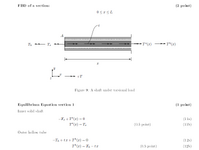There's a composite shaft, the white space is the weld and its thickness is negligible.
and there's a distributed torsional moment t, applied along the full length of the composite shaft.
That's fine, but the formulas they got for 11b, was: -Ts + T_s(x) = 0
Ts is the reaction force of the inner tube (cause the shaft is clamped to a bar)
and T_s(x) is the internal force on the inner tube.
Now my question is, why didn't they include the distributed torsional moment? Does the fact that its an inner shaft mean it doesn't experience distributed loads? and only the outer shell does?
here's the picture of the actual thing:

and as you see, 12a has tx, meaning the full distributed load tx is included on the outer hollow tube but none in the inner solid one...
and there's a distributed torsional moment t, applied along the full length of the composite shaft.
That's fine, but the formulas they got for 11b, was: -Ts + T_s(x) = 0
Ts is the reaction force of the inner tube (cause the shaft is clamped to a bar)
and T_s(x) is the internal force on the inner tube.
Now my question is, why didn't they include the distributed torsional moment? Does the fact that its an inner shaft mean it doesn't experience distributed loads? and only the outer shell does?
here's the picture of the actual thing:

and as you see, 12a has tx, meaning the full distributed load tx is included on the outer hollow tube but none in the inner solid one...
